Enhancing Construction Management Education through 4D BIM and VR: Insights and Recommendations
Abstract
:1. Introduction
2. Literature Review
2.1. Construction Management Education
2.2. BIM for Construction Management Education
2.3. VR for Construction Management Education
2.4. BIM and VR Integration
3. Materials and Methods
3.1. Experiment Design
3.1.1. First Experiment
3.1.2. Second Experiment
3.1.3. Model Creation, VR Setup and Monitoring
3.2. Participant Sampling
3.3. Development of Survey Questionnaire
3.4. Ethical Considerations
4. Results
4.1. Two-Dimensional-Based Experiment Results
4.2. Four-Dimensional-BIM VR-Based Experiment Results
4.3. Error Detection in Both Experiments
5. Discussion
5.1. Construction Sequence Errors and Engagement
5.2. Method Functionality and Spatial Understanding
5.3. Impact of Prior VR Experience
5.4. Customized Learning Environment
6. Conclusions
Author Contributions
Funding
Data Availability Statement
Acknowledgments
Conflicts of Interest
References
- Rowings, J.; Johnston, D.; Alarcon, L.; Birgönül, T.; Abudayyeh, O.; Russell, J. Construction Engineering and Management Undergraduate Education. J. Constr. Eng. Manag. 2000, 126, 169–175. [Google Scholar] [CrossRef]
- Ogunseiju, O.; Gonsalves, N.; Akanmu, A.; Bairaktarova, D.; Agee, P.; Asfari, K. Sensing technologies in construction engineering education: Industry experiences and expectations. J. Inf. Technol. Constr. 2023, 28. [Google Scholar] [CrossRef]
- Ku, K.; Mahabaleshwarkar, P.S. Building Interactive Modeling for Construction Education in Virtual Worlds. 2011. Available online: http://www.itcon.org/2011/13 (accessed on 23 May 2024).
- Sunardiyo, S. Online learning in higher education during the Covid-19 pandemic: A case study in the Department of Electrical Engineering, Universitas Negeri Semarang. IOP Conf. Ser. Earth Environ. Sci. 2021, 700, 012020. [Google Scholar] [CrossRef]
- Vasilevski, N.; Birt, J. Analysing construction student experiences of mobile mixed reality enhanced learning in virtual and augmented reality environments. Res. Learn. Technol. 2020, 28, 2329. [Google Scholar] [CrossRef]
- Shafiq, M.T.; Afzal, M. Potential of Virtual Reality Based Application for and Safety Planning Performance. In Proceedings of the 8th Zero Energy Mass Custom Home (ZEMCH 2021) International Conference, Dubai, United Arab Emirates, 26–28 October 2021. [Google Scholar]
- Abouelkhier, N.; Shawky, D.; Marzouk, M. Evaluating distance perception for architecture design alternatives in immersive virtual environment: A comparative study. Constr. Innov. 2021, 22, 205–221. [Google Scholar] [CrossRef]
- Kandi, V.R.; Castronovo, F.; Brittle, P.; Ventura, S.M.; Nikolic, D. Assessing the Impact of a Construction Virtual Reality Game on Design Review Skills of Construction Students. J. Archit. Eng. 2020, 26, 04020035. [Google Scholar] [CrossRef]
- Yang, F.; Goh, Y.M. VR and MR technology for safety management education: An authentic learning approach. Saf. Sci. 2022, 148, 105645. [Google Scholar] [CrossRef]
- Herrington, J.; Kervin, L. Authentic learning supported by technology: 10 suggestions and cases of integration in classrooms. Educ. Media Int. 2007, 44, 219–236. Available online: https://ro.uow.edu.au/edupapers/28 (accessed on 23 March 2023). [CrossRef]
- Pedro, A.; Le, Q.T.; Park, C.S. Framework for Integrating Safety into Construction Methods Education through Interactive Virtual Reality. J. Prof. Issues Eng. Educ. Pract. 2016, 142, 04015011. [Google Scholar] [CrossRef]
- Alizadehsalehi, S.; Hadavi, A.; Huang, J.C. Virtual Reality for Design and Construction Education Environment. In Proceedings of the AEI 2019, Tysons, VA, USA, 3–6 April 2019; pp. 193–203. [Google Scholar] [CrossRef]
- Li, X.; Yi, W.; Chi, H.L.; Wang, X.; Chan, A.P.C. A critical review of virtual and augmented reality (VR/AR) applications in construction safety. Autom. Constr. 2018, 86, 150–162. [Google Scholar] [CrossRef]
- Kamardeen, I. Adaptive e-Tutorial for Enhancing Student Learning in Construction Education. Int. J. Constr. Educ. Res. 2014, 10, 79–95. [Google Scholar] [CrossRef]
- Samarasinghe, D.A.; Latif, S.A.; Baghaei, N. Virtual Reality Models for Promoting Learners Engagement in Construction Studies. In Proceedings of the IEEE Global Engineering Education Conference (EDUCON), Dubai, United Arab Emirates, 30 May 2019; pp. 1331–1335. [Google Scholar]
- Pan, W.; Murray, P.; Cotton, D.; Garmston, H. Integrating Research-informed Teaching into Sustainable Construction Education. J. Educ. Built Environ. 2012, 7, 94–117. [Google Scholar] [CrossRef]
- Glick, S.; Porter, D.; Smith, C. Student Visualization: Using 3-D Models in Undergraduate Construction Management Education. Int. J. Constr. Educ. Res. 2012, 8, 26–46. [Google Scholar] [CrossRef]
- Messner, J.I.; Horman, M.J. Using Advanced Visualization Tools to Improve Construction Education. In Proceedings of the CONVR 2003 Conference, Blacksburg, VA, USA, 24–26 September 2003; pp. 814–863. [Google Scholar]
- Ao, Y.; Peng, P.; Li, J.; Li, M.; Bahmani, H.; Wang, T. What Determines BIM Competition Results of Undergraduate Students in the Architecture, Engineering and Construction Industry? Behav. Sci. 2022, 12, 360. [Google Scholar] [CrossRef]
- Babič, N.Č.; Rebolj, D. Culture Change in Construction Industry: From 2D Toward BIM Based Construction. 2016. Available online: http://www.itcon.org/2016/6 (accessed on 2 January 2023).
- Moore, H.F.; Gheisari, M. A review of virtual and mixed reality applications in construction safety literature. Safety 2019, 5, 51. [Google Scholar] [CrossRef]
- Wang, X.; Love, P.E.D.; Kim, M.J.; Park, C.S.; Sing, C.P.; Hou, L. A conceptual framework for integrating building information modeling with augmented reality. Autom. Constr. 2013, 34, 37–44. [Google Scholar] [CrossRef]
- Wang, L.; Huang, M.; Zhang, X.; Yan, X.; Jin, R.; Wanatowski, D.; Cheshmehzangi, A.; Chohan, N. Incorporating BIM into the upper-division curriculum of construction engineering and management. Eur. J. Eng. Educ. 2022, 48, 482–501. [Google Scholar] [CrossRef]
- Ghanem, S.Y. Implementing Virtual Reality-Building Information Modeling in The Construction Management Curriculum. J. Inf. Technol. Constr. 2022, 27, 48–69. [Google Scholar] [CrossRef]
- Sampaio, A.Z.; Ferreira, M.M.; Rosário, D.P.; Martins, O.P. 3D and VR models in Civil Engineering education: Construction, rehabilitation and maintenance. Autom. Constr. 2010, 19, 819–828. [Google Scholar] [CrossRef]
- Wang, P.; Wu, P.; Wang, J.; Chi, H.L.; Wang, X. A critical review of the use of virtual reality in construction engineering education and training. Int. J. Environ. Res. Public Health 2018, 15, 1204. [Google Scholar] [CrossRef]
- Alizadehsalehi, S.; Hadavi, A.; Huang, J.C. Assessment of AEC students’ performance using BIM-into-VR. Appl. Sci. 2021, 11, 3225. [Google Scholar] [CrossRef]
- Anifowose, H.; Yan, W.; Dixit, M. ACADIA 2021 2 BIM LOD + Virtual Reality. In Proceedings of the 41st Annual Conference of the Association of Computer Aided Design in Architecture (ACADIA), Online, 3–6 November 2021. [Google Scholar]
- Lucas, J.; Gajjar, D. Influence of virtual reality on student learning in undergraduate construction education. Int. J. Constr. Educ. Res. 2022, 18, 374–387. [Google Scholar] [CrossRef]
- Wilkerson, M.; Maldonado, V.; Sivaraman, S.; Rao, R.R.; Elsaadany, M. Incorporating immersive learning into biomedical engineering laboratories using virtual reality. J. Biol. Eng. 2022, 16, 20. [Google Scholar] [CrossRef]
- Na, R.; Aljagoub, D.; Webber, R. Integrating Virtual Reality (VR) Into Construction Engineering and Management (CEM) Courses-A Case Study. EPiC Ser. Built Environ. 2022, 3, 633–642. [Google Scholar]
- Luo, Y.; Wu, W.; Morales, G.; Mohammadiyaghini, E. Immersive Virtual Field Trips with Virtual Reality in Construction Education: A Pilot Study. EPiC Ser. Built Environ. 2022, 3, 614–623. [Google Scholar]
- Hussein, M.; Nätterdal, C. The Benefits of Virtual Reality in Education A Comparison Study. Bachelor’s Thesis, Chalmers University of Technology, Gothenburg, Sweden, 2015. [Google Scholar]
- Lucas, J. Student Perceptions and Initial Response to using Virtual Reality for Construction Education. In Proceedings of the 54th Associated Schools of Construction Annual International Conference Proceedings, Minneapolis, MN, USA, 18–21 April 2018; pp. 281–288. [Google Scholar]
- Tashakkori, A.; Teddlie, C. Foundations of Mixed Methods Research; SAGE Publications: Thousand Oaks, CA, USA, 2007. [Google Scholar]
- Creswell, J.; Clark, V.P. Designing and Conducting Mixed Methods Research; SAGE Publications: Thousand Oaks, CA, USA, 2017. [Google Scholar]
- Autodesk Revit: BIM Software for Designers, Builders, and Doers. Autodesk. Available online: https://www.autodesk.ae/products/revit/overview (accessed on 1 December 2022).
- EnscapeTM. Real-Time Rendering & Virtual Reality, version 3.3; EnscapeTM: Karlsruhe, Germany, 2022. [Google Scholar]
- Desai, P.R.; Desai, P.N.; Ajmera, K.D.; Mehta, K. A Review Paper on Oculus Rift-A Virtual Reality Headset. Int. J. Eng. Trends Technol. 2014, 13, 4. Available online: http://www.ijettjournal.org (accessed on 23 March 2023).
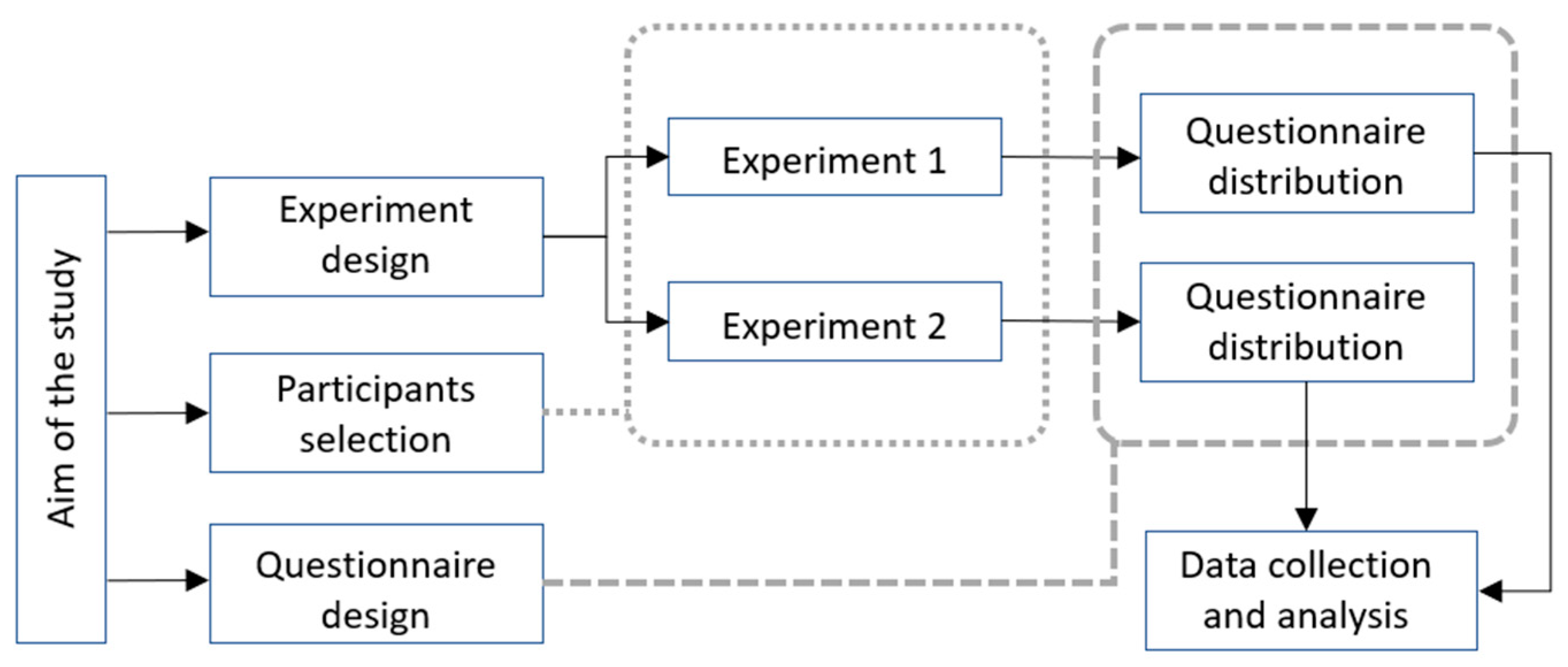

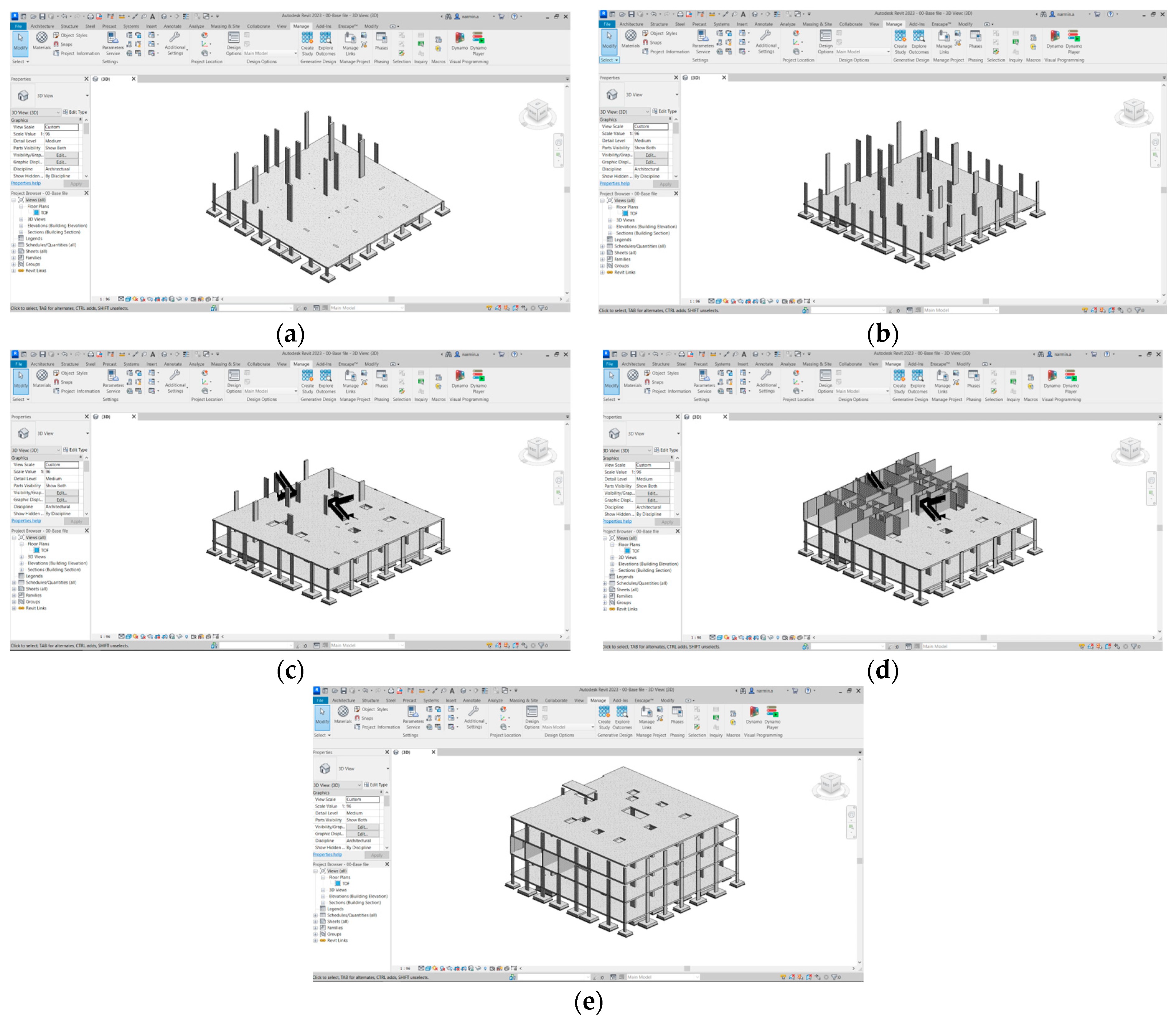
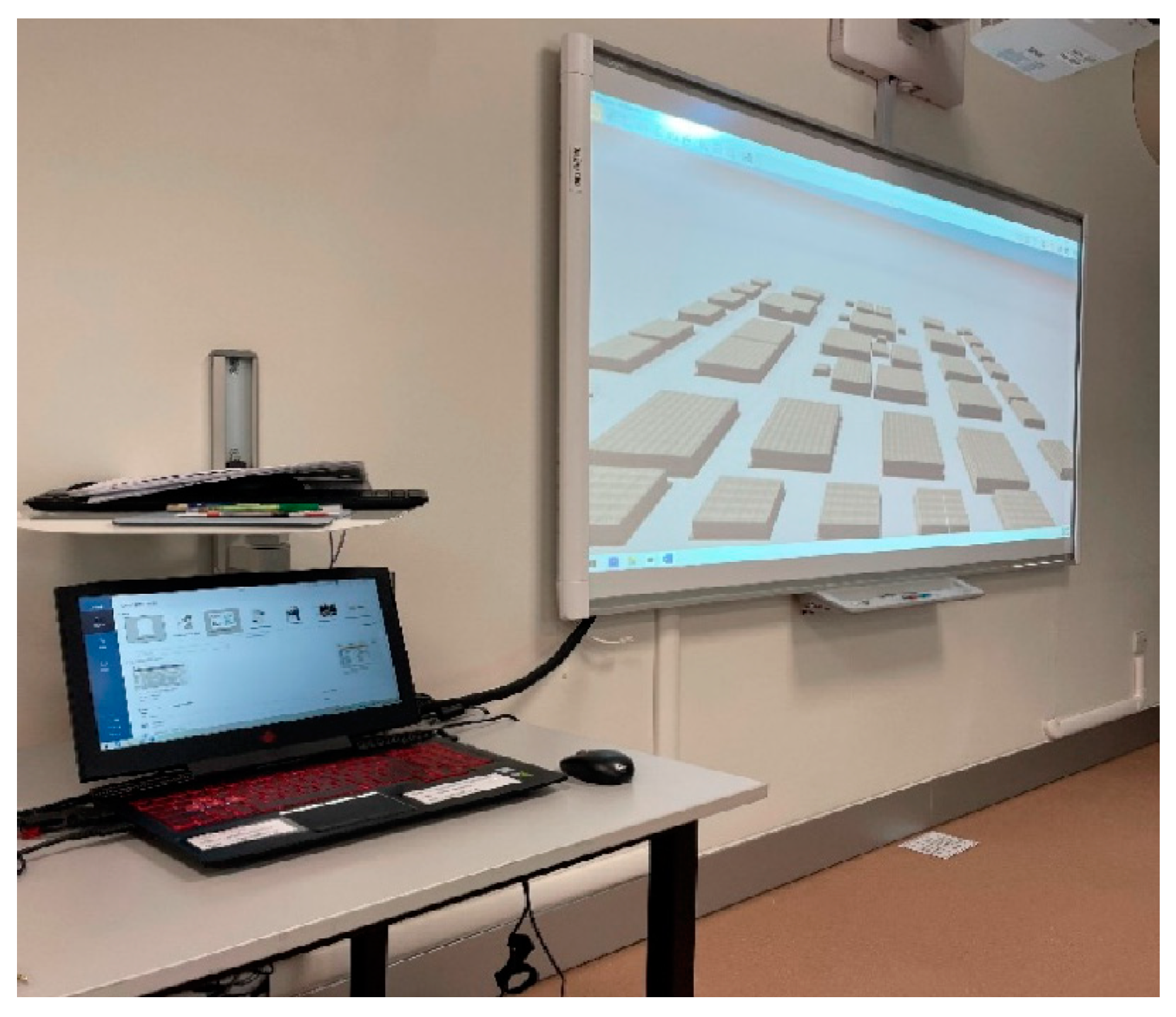

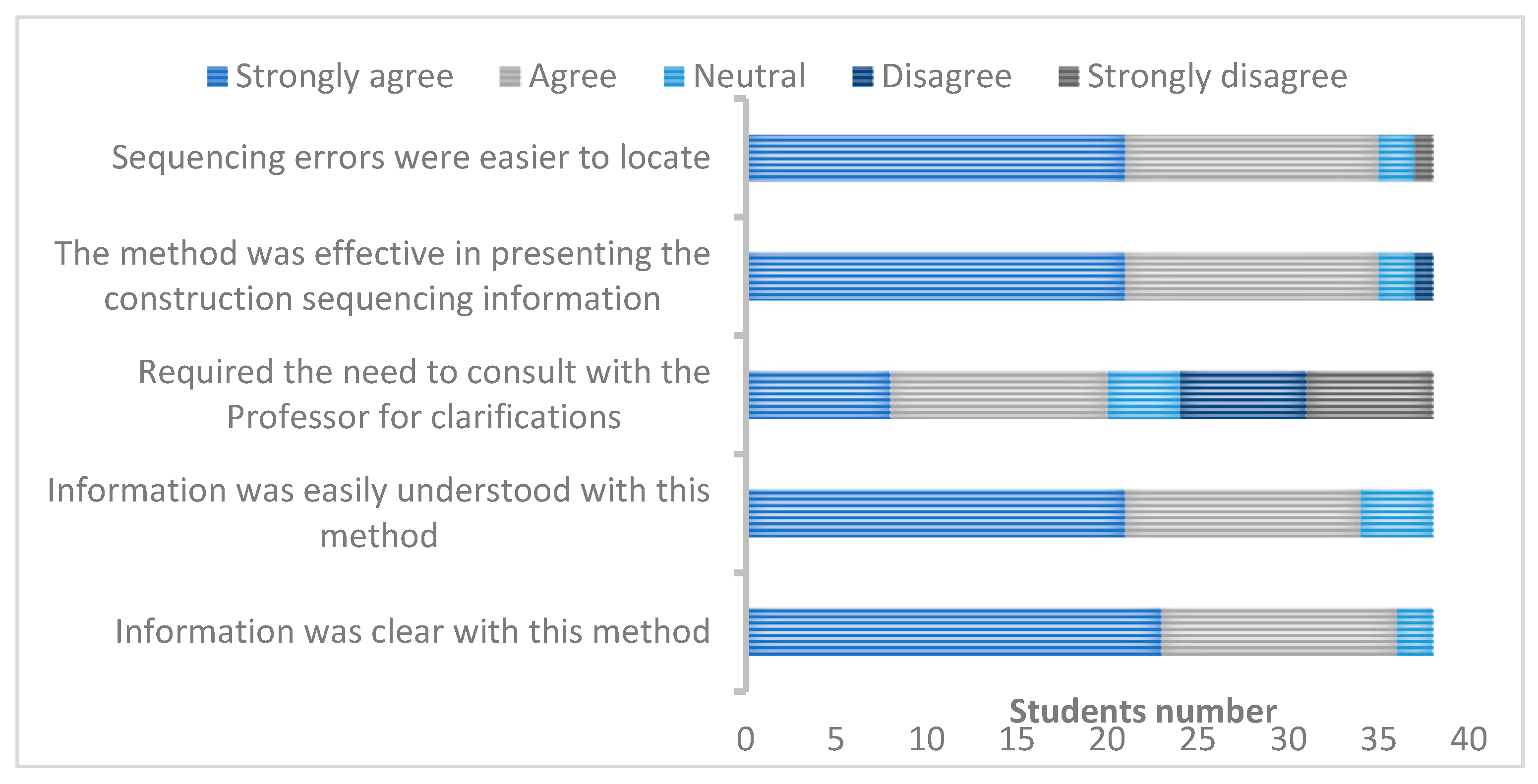
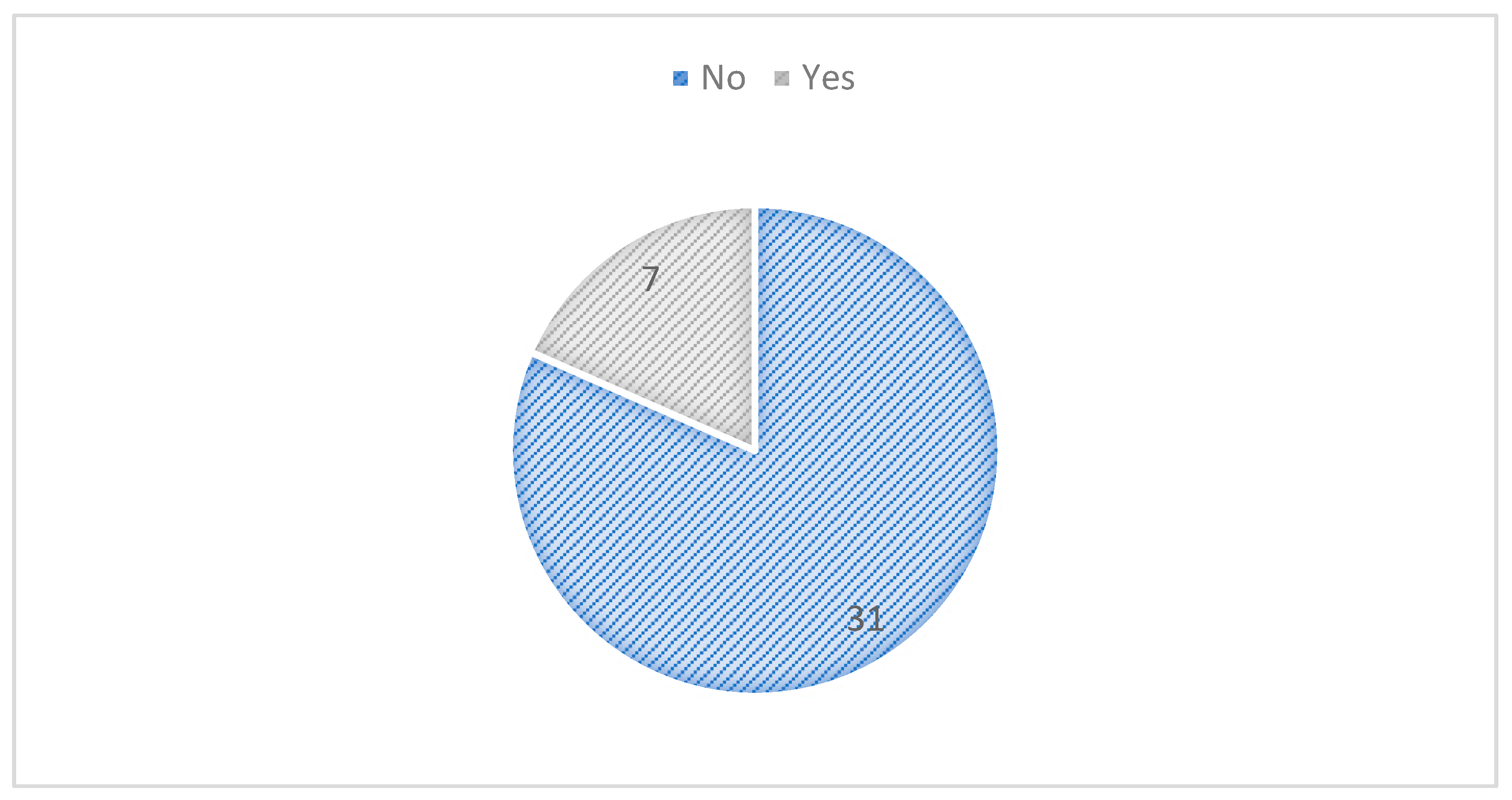
| Likert-Scale Questions | Measured Aspects |
|---|---|
| Information was clear with this method. | Method functionality |
| Information was easily understood with this method | Information delivery |
| Required the need to consult with the experiment team for clarifications | Content |
| The method was effective in presenting the construction sequencing information. | Method presentation |
| Sequencing errors/irregularities were easy to locate. | Engagement |
Disclaimer/Publisher’s Note: The statements, opinions and data contained in all publications are solely those of the individual author(s) and contributor(s) and not of MDPI and/or the editor(s). MDPI and/or the editor(s) disclaim responsibility for any injury to people or property resulting from any ideas, methods, instructions or products referred to in the content. |
© 2024 by the authors. Licensee MDPI, Basel, Switzerland. This article is an open access article distributed under the terms and conditions of the Creative Commons Attribution (CC BY) license (https://creativecommons.org/licenses/by/4.0/).
Share and Cite
Abouelkhier, N.; Shafiq, M.T.; Rauf, A.; Alsheikh, N. Enhancing Construction Management Education through 4D BIM and VR: Insights and Recommendations. Buildings 2024, 14, 3116. https://doi.org/10.3390/buildings14103116
Abouelkhier N, Shafiq MT, Rauf A, Alsheikh N. Enhancing Construction Management Education through 4D BIM and VR: Insights and Recommendations. Buildings. 2024; 14(10):3116. https://doi.org/10.3390/buildings14103116
Chicago/Turabian StyleAbouelkhier, Narmin, Muhammad Tariq Shafiq, Abdul Rauf, and Negmeldin Alsheikh. 2024. "Enhancing Construction Management Education through 4D BIM and VR: Insights and Recommendations" Buildings 14, no. 10: 3116. https://doi.org/10.3390/buildings14103116











